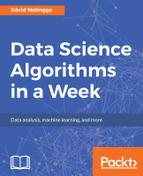We run the program implementing k-means clustering algorithm on the data from the gender classification example. The numerical argument 2 means that we would like to cluster the data into 2 clusters:
$ python k-means_clustering.py persons_by_height_weight.csv 2 last The total number of steps: 2 The history of the algorithm: Step number 0: point_groups = [((180.0, 75.0), 0), ((174.0, 71.0), 0), ((184.0, 83.0), 0), ((168.0, 63.0), 0), ((178.0, 70.0), 0), ((170.0, 59.0), 0), ((164.0, 53.0), 1), ((155.0, 46.0), 1), ((162.0, 52.0), 1), ((166.0, 55.0), 1), ((172.0, 60.0), 0)] centroids = [(180.0, 75.0), (155.0, 46.0)] Step number 1: point_groups = [((180.0, 75.0), 0), ((174.0, 71.0), 0), ((184.0, 83.0), 0), ((168.0, 63.0), 0), ((178.0, 70.0), 0), ((170.0, 59.0), 0), ((164.0, 53.0), 1), ((155.0, 46.0), 1), ((162.0, 52.0), 1), ((166.0, 55.0), 1), ((172.0, 60.0), 0)] centroids = [(175.14285714285714, 68.71428571428571), (161.75, 51.5)]
The program also outputs a graph visible in Image 5.2. The parameter last means that we would like the program to do the clustering until the last step. If we would like to display only the first step (step 0), we could change last to 0 to run:
$ python k-means_clustering.py persons_by_height_weight.csv 2 0
Upon the execution of the program, we would get the graph of the clusters and their centroids at the initial step as in Image 5.1.
